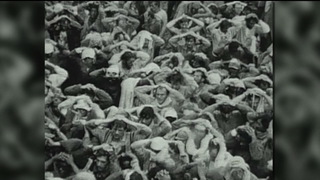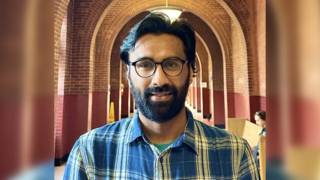
Topics
Guests
- Heather Ann Thompsonhistorian, author and activist with a long history of examining violence in prisons. Around this time last year, her most recent book won the Pulitzer Prize. It’s titled Blood in the Water: The Attica Prison Uprising of 1971 and Its Legacy. She is a professor of history at the University of Michigan in Ann Arbor.
At least seven prisoners died and 17 were seriously injured after bloody violence broke out Sunday night at a maximum security prison in South Carolina. It was the deadliest prison riot in the United States in 25 years. A coroner said all of the prisoners were stabbed, slashed or beaten. Six of the seven were African-American. No guards were hurt. In total, at least 20 prisoners have been killed by fellow prisoners in South Carolina since the start of 2017. One investigation found the number killed across the state’s prisons had quadrupled from 2015 to 2017. The state’s prison agency has also been hit with several lawsuits that outline a “long history of violence” and allege sometimes the violence is “encouraged” by guards. We speak with Pulitzer Prize-winning journalist Heather Ann Thompson, who wrote “Blood in the Water: The Attica Prison Uprising of 1971 and Its Legacy.”
Transcript
AMY GOODMAN: “Duckworth” by Kendrick Lamar, from the Pulitzer Prize-winning album DAMN. Kendrick Lamar, the first non-classical or jazz artist to receive the Pulitzer Prize in Music, and we’re going to talk about that in a moment. I’m Amy Goodman. This is Democracy Now! But first we turn to the bloody violence that broke out Sunday night at a maximum security prison in South Carolina, leaving seven prisoners dead, 17 others seriously injured, the deadliest prison riot in the United States in a quarter of a century. A coroner said all the prisoners were stabbed, slashed or beaten. Six of the seven were African-American. No guards were hurt. Department of Corrections Director Bryan Stirling held a news conference Monday to describe how authorities responded after a, quote, “inmate-on-inmate altercation”—”inmate-on-inmate altercation”—started in a general population dorm around 7:15 p.m. at the Lee Correctional Institution in South Carolina.
BRYAN STIRLING: An hour and 15 minutes later, another fight broke out in two other dorms at Lee Correctional. At 9:00, other response teams, SITCON and our SORT team, were activated, and responded. Around 9:20, 9:23, SLED responded also. At 11:30, we entered the first dorm at Lee to take that dorm back. We had enough people there to enter safely, and we took that dorm back. At 12:30, we went and entered the second dorm at Lee and safely took that dorm back. At 2:00, we entered the last dorm at Lee and started conducting the roll call counts.
AMY GOODMAN: An imprisoned source inside the Lee facility who requested anonymity gave the news outlet Prison Legal News a series of photos that appear to have been taken with a cellphone and show graphic images of dead or badly wounded bodies covered with blood and a blood-soaked floor. The photos have not yet been verified. Director Stirling said it took seven hours for guards to stop the violence Sunday night in order to maintain officer safety.
BRYAN STIRLING: Before we can go into a dorm—just so you know, there’s about 250, 260 inmates in each dorm. We’re not going to just send one or two officers in there. We’re going to gather a force that is safe for all our officers, and we’re going to go in, and we’re going to take that dorm back with force. And if there’s any resistance, we will be able to put that resistance down immediately. So we’re not going to put our officers and other staff in harm’s way. We gathered as many people as we could, as quickly as we could, and went in as soon as we thought it was safe for our staff.
AMY GOODMAN: Lee Correctional Institution has seen several other violent and deadly outbreaks before this one. Last month, prisoners reportedly overpowered an officer and took control of a part of the dorm for more than an hour. In February, a prisoner was killed by another prisoner. Another prisoner was stabbed to death in November, and another died after a fight in July. In total, at least 20 prisoners have been killed by fellow prisoners in South Carolina since the start of 2017. One investigation found the number killed across South Carolina’s prisons has quadrupled from 2015 to 2017. The South Carolina prison agency has also been hit with several lawsuits that outline a, quote, “long history of violence” and allege sometimes the violence is encouraged by guards. Meanwhile, on Monday, South Carolina Governor Henry McMaster told reporters why he thought violence had broken out Sunday night.
GOV. HENRY McMASTER: We know that prisons are places where people who have misbehaved on the outside go for rehabilitation and also to take them from the general population. It’s not a surprise when we have violent events take place inside the prison, any prison in the country.
AMY GOODMAN: For more, we’re joined in studio by Heather Ann Thompson, historian, author, activist, with a long history of examining violence in prisons. Around this time last year, her most recent book also won the Pulitzer Prize. It’s titled Blood in the Water: The Attica Prison Uprising of 1971 and Its Legacy. She’s professor of history at the University of Michigan-Ann Arbor.
Welcome back to Democracy Now!, Heather Ann Thompson.
HEATHER ANN THOMPSON: Great to be here.
AMY GOODMAN: Talk about what you understand took place in South Carolina right now.
HEATHER ANN THOMPSON: Well, I mean, horrific violence, as is becoming routine in our nation, in no small part because we just continue to fail with the understanding that when we lock people in cages and we deny them basic human rights—and in the case of South Carolina, keep them on lockdown for months and years—people become desperate and furious, and eventually human beings explode. And this has happened again and again. But the response is always: We need to make the facility more secure, not more humane.
AMY GOODMAN: Seven dead, 17 seriously injured. Since 2017, 20 dead in South Carolina’s prisons. Talk about the history of the violence at the Lee prison and others in South Carolina.
HEATHER ANN THOMPSON: Well, in South Carolina, the murder of inmates has gone up, has quadrupled in two years. And again, this stems from this endemic problem of human rights groups, judges, all the way back to 2012, telling the Department of Corrections that they need to remedy the situation in the prison, things such as letting people out of the cells more, more vocational training, more educational opportunities, and, frankly, less—fewer people inside of the institution. The response instead has been more lockdowns, fewer people outside of their cells, you know, strange things like putting metal bars—I’m sorry, metal plates over windows, that restricts airflow, cutting down on yard time so that people are actually in their cells even longer than they would normally be, problems with food distribution.
AMY GOODMAN: I want to—
HEATHER ANN THOMPSON: We just go on.
AMY GOODMAN: I want to go to South Carolina’s Department of Corrections Director Bryan Stirling, who said the violence erupted—may have erupted because of an increase in prisoners who have cellphones.
HEATHER ANN THOMPSON: Right, right.
BRYAN STIRLING: Our preliminary investigation has found that this is gangs fighting over territory. And if they’re incarcerated, then they’re going to have to have a cellphone to continue their criminal ways from behind bars. And that’s just the preliminary investigation, and more to come on that as SLED and our police services continue this investigation. But we’ve seen it over and over again. Captain Johnson—I don’t know if anybody was at the crime victims thing last week and heard his impassioned speech about cellphones. He was shot multiple times in his house. We’ve had people arrested here. There’s been people arrested, inmates from Georgia, California. Charles Manson had a cellphone. It’s a problem.
AMY GOODMAN: So, the corrections director, Bryan Stirling, said he is set to meet with the FCC next month. Meanwhile—that’s the Federal Communications Commission. South Carolina’s House minority leader, Democrat Todd Rutherford, has said prison staff should immediately begin monitoring prisoners’ cellphone conversations and text messages. And a prisoner who provided graphic photos of Sunday’s violence to the news outlet Prison Legal News said cellphones were not actually at the center of the dispute, but rather other items that one gang faction said were stolen from another. He said, quote, “This has been [an] ongoing beef from an incident that happened at Lieber Correctional Institution. Bloods and Folks have been fighting for over a year. What SCDC does is when a gang fight happens, they move inmates to other institutions. They meet up with other members and what they do is put those guys in dorms with the gang that the person just got into [it] with.”
HEATHER ANN THOMPSON: Yes. You know, it’s really extraordinary. The department is talking about cellphones. The fact is that cellphones are the only reason we know anything about what’s going on in these institutions. This is not just true in South Carolina, it’s true across the country. These are public institutions, but they’re super-closed. We don’t know what’s happening in them. So, if we take away cellphones, we have a real problem.
The real issue is, in fact, that we do have deep hostilities in prison. We do have a situation where we put rival gangs in the same unit. Often, in the California system, for example, we’ve seen that as absolute sport, to see what will happen, on the part of corrections officials.
But at the end of the day, again, we have a situation where we know how to make prisons safer. One of the worst-ever prison uprisings that turned violent, killed 33 prisoners, was in New Mexico in 1980. And that was in no small part because Pell program had been shut down. Prison—
AMY GOODMAN: That’s the education program.
HEATHER ANN THOMPSON: That’s right. All of the educational programs had been stopped, and much more time in the cells, much more frustration. And so, again, it’s this willful lack of recognizing what creates violence in a prison.
AMY GOODMAN: Taking away all hope.
HEATHER ANN THOMPSON: Yeah, and Nikki Haley, for example, you know, as governor, had proposed—
AMY GOODMAN: of South Carolina.
HEATHER ANN THOMPSON: That’s right—proposed $18 million to go to making these institutions more secure. And meanwhile, of course, we know that what we need is not so much of an emphasis on security, even though it seems that way with these murders. What we need is less cell time and more family time. That’s the other thing about this—
AMY GOODMAN: You’re talking about “cell” as a prison cell.
HEATHER ANN THOMPSON: That’s right. That’s right.
AMY GOODMAN: Not cellphone time.
HEATHER ANN THOMPSON: And the cellphones—even the cellphones, actually, are the way in which people on the inside are tethered still to their families, because we’ve privatized the phone industry in prisons so that it’s too expensive for them to call home. So, this is really an extraordinary moment where we are, again, missing what folks know to be the problem and what might the—what the solution should be.
AMY GOODMAN: Do you know the percentage of African-American prisoners in South Carolina?
HEATHER ANN THOMPSON: Oh, I mean, it’s staggering. I mean, it’s staggeringly disproportionate. And, you know, we know that it’s not just that it’s staggeringly racially disproportionate, it’s also the poorest people in the state—a state, incidentally, that has 30 percent of its children living under the poverty line, almost 19 percent of adults. So, this is a deeper problem.
AMY GOODMAN: So, this time last year you had just heard you had won the Pulitzer Prize for Blood in the Water: The Attica Prison Uprising of 1971 and Its Legacy. How do you see this relating to what happened September 9th to 13th, 1971? How many prisoners were killed at Attica when they rose up to demand better conditions at the prison?
HEATHER ANN THOMPSON: Well, I mean, Attica’s lessons are that if you do not treat people as human beings inside of institutions, they will eventually erupt. And in the case of Attica, it was quite different, in that the prisoners had a quite remarkably peaceful and democratic uprising, and the bulk of the violence in that instance was when the prison was retaken by law enforcement, law enforcement killing 39, both prisoners and guards. And, you know—
AMY GOODMAN: And it was all guards then who did the killing.
HEATHER ANN THOMPSON: Well, state troopers.
AMY GOODMAN: State troopers, I meant, right.
HEATHER ANN THOMPSON: Exactly, and a few corrections officers. And there were also deaths inside of the prison, just as in this case, at the hands of fellow prisoners. But the overwhelming uprising was peaceful. And we missed the opportunity to take the lesson from Attica. We missed the opportunity to understand what it takes to make institutions safer and what it takes to treat people humanely.
AMY GOODMAN: You’ve served on a National Academy of Sciences blue-ribbon panel that studied the causes and consequences of mass incarceration in the U.S. Interestingly, the book this year that won the Pulitzer Prize, like yours, deals with prisons.
HEATHER ANN THOMPSON: That’s right.
AMY GOODMAN: But talk about what—the recommendations that you made then and what you think has to happen now.
HEATHER ANN THOMPSON: Well, the report that was issued by the National Academies made very clear that we are going in the wrong direction, that longer sentences do not make us safer, that prisons do not make us safer, and that we took a very, very bad policy turn 40 years ago, and that this is something that we can correct, that we can reverse what we’ve done. But it’s going to take political will. And notably, we were on the verge of doing some of that prior to the last election. And I think we’ve lost tremendous ground. It is remarkable that, again, this is one of these state problems, local problems, city problems, where we know the solution, and yet politicians repeatedly go back to the punitive playbook.
AMY GOODMAN: Something you didn’t know at the time of the writing of Blood in the Water, your book, was about doctor experimentation on prisoners?
HEATHER ANN THOMPSON: That’s right. That’s right. And I think this was—this is the other part about the Lee Correctional facility uprising that we need to think about: Why is it that we don’t know anything that’s going on in these institutions until they erupt?
AMY GOODMAN: What are the doctor experiments you didn’t know about?
HEATHER ANN THOMPSON: Well, in the case of Attica, there were experimentation—there was experimentation relating to the treatment of leprosy, countless, countless other experiments. And it’s very common. I mean, prior to the 1980s, there was a lot of experimentation in prisons. Just one of the many things that goes on behind bars of which the public is unaware, and yet we continue to throw money at the problem.
AMY GOODMAN: Well, I want to thank you for being with us. Heather Ann Thompson is an American historian, author, activist, won the Pulitzer Prize for the Attica uprising book she wrote, Blood in the Water: The Attica Prison Uprising of 1971 and Its Legacy. It’s now being adapted for a film. She’s professor of history at University of Michigan-Ann Arbor.
When we come back, Pulitzer Prizes, a first this year. We’re going to talk about the significance of the hip-hop artistry of Kendrick Lamar. Stay with us.












Media Options